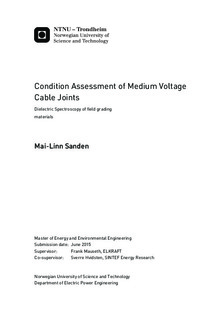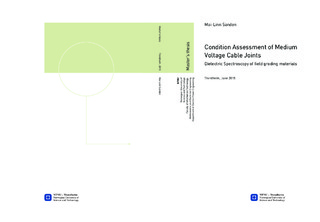| dc.description.abstract | This thesis examines the electrical properties of a commonly used stress control tube for medium voltage heat-shrink joints using non-destructive methods in laboratory. The electrical properties of the tube were determined by use of dielectric spectroscopy while changing the temperature, AC electric field and humidity level. In order to characterize the material, both differential scanning calorimetry and water uptake measurements was performed on samples of stress control tube.
Two similar test objects were used in order to obtain a higher electric field strength at the same applied AC voltage. A Raychem stress control tube was shrunk on the outside of a cylindrical shape consisting of two metal electrodes and a PTFE rod separating them. The length of the PTFE rod was 100 mm for Object L, while only 20 mm for Object S providing a higher field strength.
Water uptake measurement was performed in order to determine the stress control tube s ability to diffuse water. Measurement results imply that the water uptake is dependent of both the degree of shrinkage and the temperature. The highest water content is observed for a virgin stress control tube kept at 90 ℃, with a concentration of 8 % after 105 days. None on the test samples reached saturation during the experimental work.
Differential scanning calorimetry measurement was performed in order to examine if the stress control tube had any phase transitions changing the electrical properties of the stress control tube. Samples of stress control tube were examined in the temperature range of 20 ℃ to 200 ℃. Results indicate that the stress control tube, independent of the degree of shrinkage, has an endothermic melting transition in the temperature range of 94 ℃ to 114 ℃. Dielectric response measurements show that the thermal transition of the stress control tube will provide an increased conductivity. This is likely caused by a change from semi-crystalline to amorphous state, releasing trapped charge carriers and providing the material to become more electrical conductive.
Dielectric spectroscopy was performed on both test objects in the electric field range from 0.025 1.0 kVpeak/mm for Object S and 0.005 0.01 kVpeak/mm for Object L. Frequency was varied from 100 Hz to 1 mHz. A temperature dependence was observed for dielectric loss tangent, in addition to large values up to 1000. At higher temperatures, the dielectric loss tangent was observed independent of the electric field. For measurements at 40 ℃, an electric field dependence is observed for field strengths above 0.5 kVpeak/mm.
The results show that the conductivity is dependent of the temperature. After exposed to 150 ℃, the temperature is decreased to 40 ℃ and a new measurement is performed. Hysteresis effect is then observed as the conductivity attains a higher value than before exposed to high temperatures.
The conductivity is found independent at the electrical field at high temperatures. At low temperatures, the electrical field dependence is observed for field strengths above 0.5 kVpeak/mm. Observations made imply that the conductivity is strongly dependent of the humidity level. When performing dielectric response measurement on a wet test object, the conductivity experienced a significant increase from 10-11 to 10-5 S/m.
Wet stress control tube was dissected after complete dielectric response measurement. There was not observed signs of tracking, causing the electrodes to be short-circuited during measurements. | |

